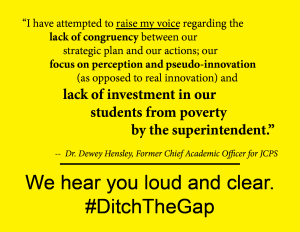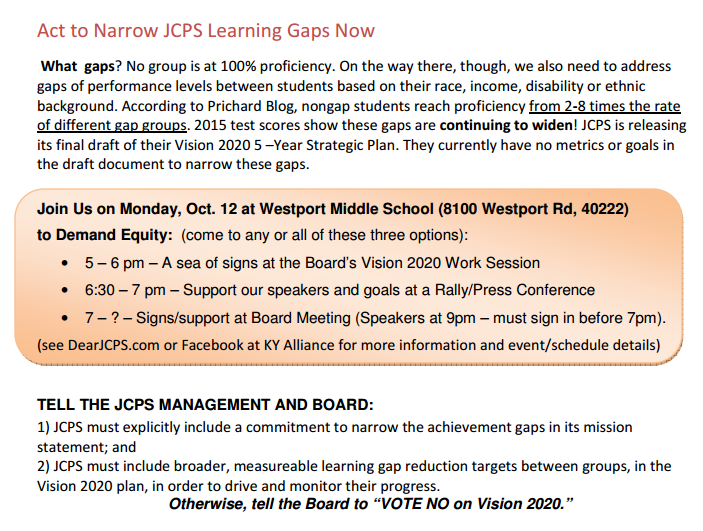Vision: 2020
# DitchTheGap Coalition Actions and Press Conference before and during JCPS Board meeting, Westport Middle School, Monday October 12
As of 2014, 45% of all Jefferson County Public Schools (JCPS) students reached math and reading proficiency. For Latino students, though, that number was 40%—less than 3/4 the rate for all white students. For African American students, it was only half the rate for white students. Only one out of three students from families with low incomes was proficient. Special needs students and English language learners scored even lower. For 2012-2015, the increase in the % proficient of all these ”gap” students was less than one quarter of the JCPS target. The gaps are clearly real. And just as clearly, JCPS does not have the right goal and plan in place to narrow them.
Help us change the course of JCPS.
Below are talking points for contacting the JCPS Superintendent, the Board Chair, and your School Board member. Share your stories about the impacts of the gaps on your family, too. And join us again at the Van Hoose Center for the final vote on October 26! Click here to contact your board member.
#DitchTheGap Coalition: Facts and Talking Points– Gap reduction in JCPS
- More than 150 years ago, Horace Mann said that universal education is the “balance wheel” of American society. JCPS’ mission needs to emphasize this goal. JCPS’ budget and programs need to be evaluated on their impact moving toward it. Twelve (+) years in JCPS must reduce the learning and skills gaps compared with advantaged students and create a more level competitive field at graduation. Failing that, JCPS is part of institutionalizing the race and class inequity that persists in our society and community.
- There is precedent. Seattle Public Schools Policy #0030 (8/15/2012) on Ensuring Educational and Racial Equity says in part:
“…Seattle Public schools will: Raise the achievement of all students while narrowing the gaps between the lowest and highest performing students; …”
This does not mean giving up all improvements for higher-performing students. It is a matter of rebalancing budget priorities, resources and programs—and adding resources when necessary .
- KY Department of Education data for 2012-2014 showed that math and reading proficiency rates rose for every JCPS demographic group— by race/ethnicity, family income level, English language learners, and special needs . However, in every comparison, the generally more-advantaged white student group rose by more percentage points than the specific gap group. By this proficiency measure, those gaps To close gaps, we need improvement in the so-called “gap” groups at a faster pace than in higher- performing students.
- Proficiency gains in 2015 leveled off at a “plateau ”,in the words of Superintendent Hargens. In reality, since 2012, combined math and reading scores for the combined (“nonduplicated”) gap group went up far slower than targeted. The increase was less than one quarter of the JCPS Vision 2015 goal for that period. This calls into question the credibility and advisability of JCPS’ call to “stay the course” for five more years.
- “What would a commitment be without metrics…?” –Superintendent Donna Hargens (February, 2015)
JCPS leadership –in concert with teachers and other experts– must research available alternatives to institute broader, measurable indicators of demonstrated student progress in learning gap reduction across all groups, grades and performance levels. Not only would these be more timely and useful to classroom teachers’ ongoing adjustments for student learning, they would be less likely to be “gamed” for short-term improvements against state and school goals. Using the intense, once-a-year state testing may be a requirement currently imposed on JCPS, but they should be used only as an interim option. It makes no sense to enshrine these assessment measures for the next five years.
- A measurable learning gap target would be a new driver, a new lens for every evaluation and evidence-based Here are some possibilities from this year’s Board agendas where Board actions might have changed: construction/rehabilitation decisions; more aggressive hiring of minority teachers; more engaging magnets–without high academic thresholds for initial acceptance; fine-tuning student/teacher ratios based on classroom demographics; intensive, extended pre-K development programs; budgets for faster rollout of programs for pre-emptive teaching, modeling, and assessing of behavior instead of suspensions. The opportunities for impact are endless.
Dear JCPS has been invited to be part of a coalition of organizations that plans to ask the school board to add a metric for measuring success in closing the achievement gap in the Vision 2020 draft that will be presented at the Oct. 12 board meeting. This dovetails perfectly with our group’s mission of ADVOCATING for equity BEFORE the school board votes on important issues, so Dear JCPS will be supporting their movement. More information about the initiative is detailed on our Ditch The Gap page on our website.
The #DitchTheGap Coalition will be holding a press conference Monday night at 6:00 pm in front of Van Hoose regarding the achievement/learning gaps between disadvantaged and advantaged children, encouraging JCPS to include policy and measurable targets for narrowing those gaps in the Vision 2020 document. Please join us and show JCPS we are serious about wanting them to #DitchTheGap.
Achievement gaps: Differences in achievement between groups of students; including gaps by gender, race, eligibility for free or reduced-price meals, disability, or limited English proficiency; must be examined annually by school councils and addressed in council plans to eliminate those differences in achievement. (Source: Prichard Committee)
Also, join the conversation on Twitter and Facebook at #DitchTheGap and for a Twitter Storm on Monday, Sept. 28 starting at 5:00 pm.
The following Open Letter was recently submitted to the Dear JCPS website.
Topic: Vision 2020
Addressed to: JCPS and members of our community
School(s) Affected: All
Open letter to JCPS and members of our community,
The Fellowship of Reconciliation and the Kentucky Alliance against Racist and Political Repression are asking individual parents, teachers and students, and community groups to join with us and directly contact their JCPS school board members and Superintendent Donna Hargens before the draft five-year plan–Vision 2020– comes out next week. We urge JCPS to make achievement gap reduction a specific part of JCPS’ mission statement, and to develop and include specific, measurable achievement/learning gap reduction measures and goals in the Vision 2020 plan as well.
Why is this necessary? State testing data show achievement gaps are alive and well. Isn’t it a key goal of U.S. public education to reduce unearned advantages and give struggling students the additional help they need to break out of the cycle of poverty or other barriers?
Consider the policy that Seattle Public Schools passed a couple of years ago. It is an appropriate model for a mission statement for a diverse public system like ours. See the first bullet that says the job of public schools is to raise achievement/performance of all students while at the same time narrowing the gap between the highest and the lowest performers. That should be our mission as a district, given that roughly three quarters of our students fall in at least one of the “gap” groups. We can’t fix all the problems of the society that burdens these students through no fault of their own, but if JCPS doesn’t put more resources against mitigating their impacts and the gap, JCPS must own some of the responsibility for perpetuating that inequity. Education is the best single tool to break the cycle of poverty–if it helps students overcome the gaps.
We need a measurable gap reduction target in the new five-year plan so that JCPS management success is aligned with actual reduction of the gaps. The coalition’s achievement gap work earlier this year shows bar graphs from the KDE’s 2014 JCPS “Report Card” data on achievement. Every student subgroup actually saw higher proficiency levels over the time period, This is a metric of limited value, unfortunately, because it says nothing about what improvement there was–or wasn’t– for lower performing students who were not close to proficiency. However, JCPS uses it, so we took each proficiency number and subtracted it from the proficiency number for the white student group to get an actual “achievement gap” . That is in the second bar graph in that document. It shows gaps increasing over the first couple of years of Superintendent Hargens’ watch.
The fact that we had to construct a measure ourselves tells you where this is in JCPS’ priorities.
The next data is a screen shot of trends from the KDE “Report card” web page. It shows the four trends that have state targets for JCPS. JCPS did well on the first three, but on the fourth –” nonduplicated gap group proficiency” — JCPS was at 34%, only 18% of the needed increase up to their 2015 state goal of 51.2%. Superintendent Hargens confirmed in January 2015 that they believed they would reach this goal in the testing in April 2015.
Those numbers will be released publicly to the KDE website the first week in October. Originally, the JCPS board was to vote on a new five-year plan Sept 28. We –Fellowship of Reconciliation and KY Alliance against Racist and Political Repression–have asked that it be delayed until after the new state data comes out, so the public can see if the current programs are meeting targets and closing gaps. The jump all the way to 51.2% seems highly unlikely. We urge delaying release/public comment till after the data release. That would result in a better, evidence-based five year plan.
The text of what we submitted during the first public comment period earlier this summer summarizes these points.
Additionally, here’s a link to a JCPS Powerpoint that shows how the assignment target ranges have spread over the years, making it easier to hit school diversity goals. Open it, and go to slide 19. The assignment plan ranges show up in the “challenges” section, on the right.
It appears we are mostly meeting our diversity goals by broadening the acceptable ranges. Acceptable range for low-income students in our schools today are 25-90% of the student body. This, in spite of the fact that research inside and outside of Jefferson County shows that low-income students do better when they are not assigned to high-poverty schools. The original goals for minority diversity were 15-50%. Today they are also 25-90%.
We are also intrigued by the parallels with the recent furor over the lack on appointment of an African American to the U of L board, given the history of trying to be proportional to the size of the size of the African American student body there. If the same standard would be applied to our urban k-12 districts, JCPS would have 3-4 people of color on the board. If that were the case we might not find ourselves in this current position regarding large and growing achievement gaps.
We also heard today that the Prichard Commission is going to focus a task force this fall on reducing achievement gap state wide. Maybe now is the time for JCPS to step up, too.
Public schools are for the public good, and that means for greater equity in our society. JCPS needs to commit in its plan/mission to not just move all groups ahead, but to strike the resource balance among its programs–old and new–so that gaps narrow. And it needs metrics to see if it delivers for the parents and students. We urge community organizations to stand up and join with us in moving JCPS toward equity.
502/899-4119
for Fellowship of Reconciliation (FOR nonviolence@gmail.com)
and KY Alliance against Racist and Political Repression


